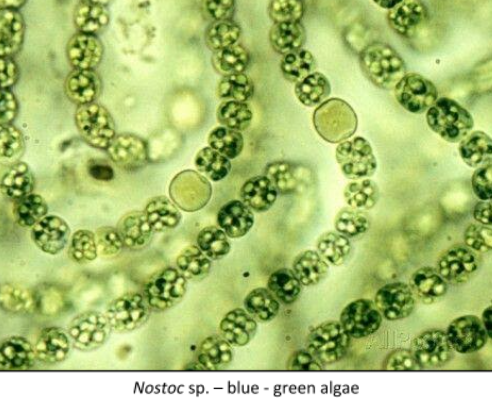
The algae bringing about nitrogen fixation:
A. Nitrosomonas
B. Nostoc
C. Pseudomonas
D. Chlamydomonas
Answer
495.3k+ views
Hint: Nostoc is a cyanobacterium and such organisms are also called blue-green algae. This bacterium oxidizes ammonia into nitrite as a metabolic process.
It is known as nitration (a step of Nitrification).
Complete answer: Nitrosomonas is a genus of Gram-negative and rod-shaped chemoautotrophic bacteria. It cannot fix atmospheric nitrogen.
Nostoc is a genus of cyanobacteria in the family Nostocaceae.
It has common names such as star jelly, mare's eggs, facia, etc.
It is a microorganism composed of beaded filaments that aggregate to form a gelatinous mass. These grow in water and damp places.
Nostoc species are able to fix nitrogen from the atmosphere.
These species establish nitrogen-fixing symbiotic associations with representatives of the four types of terrestrial plants: some bryophytes (hornworts and liverworts), the pteridophyte Azolla, gymnosperm cycads, and the angiosperm Gunnera.
Nostoc, Anabaena are cyanobacteria but also are known as blue-green algae.
Hence, these are the “algae” which can take part in nitrogen fixation.

Pseudomonas bacterium is a genus found widely in the environment, e.g. in soil, water, and plants. These can reduce the nitrates back into nitrogen gas (
Chlamydomonas is a genus of single-celled green algae. These are found in soil and freshwater. These are unable to fix atmospheric nitrogen.
So, the correct answer is B. Nostoc.
Note: In Nostoc sp., heterocyst is the cellular site of nitrogen fixation.
It protects nitrogenase from inactivation by
It is known as nitration (a step of Nitrification).
Complete answer: Nitrosomonas is a genus of Gram-negative and rod-shaped chemoautotrophic bacteria. It cannot fix atmospheric nitrogen.
Nostoc is a genus of cyanobacteria in the family Nostocaceae.
It has common names such as star jelly, mare's eggs, facia, etc.
It is a microorganism composed of beaded filaments that aggregate to form a gelatinous mass. These grow in water and damp places.
Nostoc species are able to fix nitrogen from the atmosphere.
These species establish nitrogen-fixing symbiotic associations with representatives of the four types of terrestrial plants: some bryophytes (hornworts and liverworts), the pteridophyte Azolla, gymnosperm cycads, and the angiosperm Gunnera.
Nostoc, Anabaena are cyanobacteria but also are known as blue-green algae.
Hence, these are the “algae” which can take part in nitrogen fixation.

Pseudomonas bacterium is a genus found widely in the environment, e.g. in soil, water, and plants. These can reduce the nitrates back into nitrogen gas (
Chlamydomonas is a genus of single-celled green algae. These are found in soil and freshwater. These are unable to fix atmospheric nitrogen.
So, the correct answer is B. Nostoc.
Note: In Nostoc sp., heterocyst is the cellular site of nitrogen fixation.
It protects nitrogenase from inactivation by
Latest Vedantu courses for you
Grade 10 | CBSE | SCHOOL | English
Vedantu 10 CBSE Pro Course - (2025-26)
School Full course for CBSE students
₹35,000 per year
Recently Updated Pages
Express the following as a fraction and simplify a class 7 maths CBSE

The length and width of a rectangle are in ratio of class 7 maths CBSE

The ratio of the income to the expenditure of a family class 7 maths CBSE

How do you write 025 million in scientific notatio class 7 maths CBSE

How do you convert 295 meters per second to kilometers class 7 maths CBSE

Write the following in Roman numerals 25819 class 7 maths CBSE

Trending doubts
A boat goes 24 km upstream and 28 km downstream in class 10 maths CBSE

The Equation xxx + 2 is Satisfied when x is Equal to Class 10 Maths

What are the public facilities provided by the government? Also explain each facility

Difference between mass and weight class 10 physics CBSE

SI unit of electrical energy is A Joule B Kilowatt class 10 physics CBSE

Why is there a time difference of about 5 hours between class 10 social science CBSE




